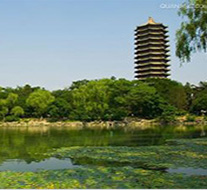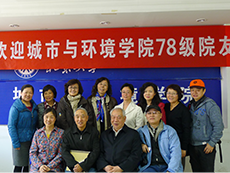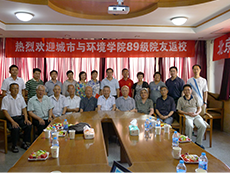
Xiaoxia Lu
Title:Associate professor
Research Direction: Environmental behavior and health effect of emerging contaminants, Remediation of contaminated environment
Department: Department of Environmental Science
Email:luxx@urban.pku.edu.cn
Education and experience
Ph.D. 1996.9-2000.7, Environmental Geography, Department of Urban and Environmental Sciences, Peking University
M.S. 1993.9-1996.7, Environmental Science, Department of Environmental Sciences, China University of Geosciences (Beijing)
B.S. 1989.9-1993.7, Hydrogeology, Department of Hydrogeology, East China Institute of Technology
Work Experience
2005.10 - present, Associate Professor, College of Urban and Environmental Science, Peking University
2013.2-2014.2, Visting scholar, School of Public Heath, Harvard University, USA
2009.7-2009.9, Visiting schloar, Institute of Environment and Health, State University of New York at Albany, USA
2002.9-2005.9, Postdocatoral Research Associate, Division of Ground Water and Ecosystem Resotration, U.S. Environmental Protection Agency
2000.8-2002.8, Postdocatoral Research Associate, Department of Environmental Science and Engineering, Tsinghua University
1999.3-2000.3, Research Assistant, TNO Institute of Environment, Energy and Process Innovation, the Netherlands
Fund Project
2022,Teaching Excellence Award of Peking University
2021, Shuren College Teacher Award of Peking University
2016, First Prize of Beijing Science and Technology Award (Rank 12th)
2012, Excellent Head Teacher of Peking University
2010,New Century Talent Award of the Ministry of Education of China
2007, Second prize of the Natural Science Award of the Ministry of Education of China (Rank 2nd)
2005,Third prize of Beijing Science and Technology Award (Rank 3rd)
Fund Project
Hosted Projects
(1) Risk Assessment of Neonicotinic Pesticides on Neurotoxicity of Beijing Tianjin Population (2018-2021), General Program of National Natural Science Foundation of China
(2) Content characteristics and environmental behavior of neonicotinic pesticides in soil of Beijing Tianjin region (2015-2018), general program of National Natural Science Foundation of China
(3) Study on the Interaction between Artificial Nanomaterials and Soil Microorganisms (2011-2013), General Program of National Natural Science Foundation of China
(4) Microbial degradation of PBDEs in sediments and its influencing factors (2009-2011), general project of NSFC
(5) Study on Biological Wall Technology for In situ Remediation of Groundwater Polluted by Chlorinated Hydrocarbons (2008-2010), Huo Yingdong Education Fund Project
(6) Multi medium fate model of regional pollutants (2007-2011), subject of 973 Program of the Ministry of Science and Technology
(7) Ecotoxicological effects of polycyclic aromatic hydrocarbons on soil microorganisms (2006-2008), President Fund of Peking University
(8) Research on joint phyto microbial remediation of petroleum hydrocarbon contaminated groundwater system (2002-2005), Youth Program of National Natural Science Foundation of China
(9) Research on microbial remediation of polycyclic aromatic hydrocarbons contaminated soil system (2001-2003), research startup fund project for returned students
(10) Microbial degradation of polycyclic aromatic hydrocarbons (PAHs) in oil contaminated soil (2001-2002), China Postdoctoral Science Fund project
Participated Projects
(1) Multi-medium interface process and biological impact mechanism of soil composite pollution (2020-2024), major project of National Natural Science Foundation of China
(2) Migration process and main control factors of persistent organic pollutants in contaminated site soil and underground aquifer (2020-2023), a national key research and development program of the Ministry of Science and Technology
(3) Research on Risk Assessment and Early Warning of Contaminated Soil Environment in Petrochemical Sites (2018-2022), a national key R&D program of the Ministry of Science and Technology
(4) Simulation Study on the Evolution of Shallow Lake Ecosystem (2011-2014), a key project of NSFC
(5) Microbial remediation of oil contaminated soil (2000-2002), general project of National Natural Science Foundation of China
Courses
Teaching Courses
(1) Graduate course, Control and Remediation of Contaminated Soil
(2) Undergraduate course, Remediation of Contaminated Environment
(3) Graduate/Undergraduate course, Frontier lecture on Environmental Sciences
Publications
(1) Zhou Y., X. Lu, B. Yu, D. Wang, C. Zhao, Q. Yang, Q. Zhang, Y. Tan, X. Wang, J. Guo. 2021. Comparison of neonicotinoid residues in soils of different land use types, Science of the Total Environment, 781: 146803.
(2) Yu, B., Z. Chen, X. Lu, Y. Huang, Y. Zhou, Q. Zhang, D. Wang, J. Li. 2020. Effects on soil microbial community after exposure to neonicotinoid insecticides thiamethoxam and dinotefuran. Science of the Total Environment, 725, 138328.
(3) Zhou, Y., X. Lu, X. Fu, B. Yu, D. Wang, C. Zhao, Q. Zhang, Y, Tan, X. Wang. 2018. Development of a fast and sensitive method for measuring multiple neonicotinoid insecticide residues in soil and the application in parks and residential areas. Analytica Chimica Acta, 1016: 19-28.
(4) Zhang, S., N. Merino, N. Wang, T. Ruan, X. Lu. 2017. Impact of 6:2 fluorotelomer alcohol aerobic biotransformation on a sediment microbial community, Science of the Total Environment, 575: 1361-1368.
(5) Zhang, S., X. Lu*, N. Wang, C.B.Robert. 2016. Biotransformation potential of 6:2 fluorotelomer sulfonate (6:2 FTSA) in aerobic and anaerobic sediment. Chemosphere, 154: 224-230.
(6) Zhang, S., Z. Hou, X. Du, D. Li, X. Lu*. 2016. Assessment of biostimulation and bioaugmentation for removing chlorinated volatile organic compounds from groundwater at a former manufacture plant. Biodegradation, 27(4): 223-236.
(7) Zhu, B., X. Xia, S. Wu, X. Lu, X. Yin. 2016. Microbial bioavailability of 2,2`,4,4`-Tetrabromo-diphenyl ether (BDE-47) in natural sediments from major rivers of China. Chemosphere, 153: 386-393.
(8) Zhu, B., S. Wu, X. Xia, X. Lu, X. Zhang, N. Xia, T. Liu. 2016. Effects of carbonaceous materials on microbial bioavailability of 2,2,4,4-tetrabromodiphenyl ether (BDE-47) in sediments. Journal of Hazardous Materials, 312: 216-223.
(9) Wu, J., C. Yu, Y. Tan, Z. Hou, M. Li, F. Shao, X. Lu*, 2015. Effects of prenatal exposure to silver nanoparticles on spatial cognition and hippocampal neurodevelopment in rats. Environmental Research, 138: 67-73.
(10) Shen Z., Z. Chen, Z. Hou, T. Li, X. Lu*, 2015. Ecotoxicological effect of zinc oxide nanoparticles on soil Microorganisms. Frontier of Environmental Science & Engineering, DOI 10.1007/s11783-015-0789-7.
(11) Lu, X., L. Lessner L, D.O. Carpenter, 2014. Association between hospital discharge rate for female breast cancer and residence in a zip code containing hazardous waste sites. Environmental Research, 2014, 134: 375–381.
(12) Zhang, S, B. Szostek, P.K. McCausland, B.W. Wolstenholme, X. Lu*, N. Wang, R.C. Buck, 2013. 6:2 and 8:2 fluorotelomer alcohol anaerobic biotransformation in digester sludge from a WWTP under methanogenic conditions. Environmental Science & Technology, 47(9): 4227-4235.
(13) Lu, X*, C. Chen, S. Zhang, Z. Hou, J. Yang, 2013. Concentration levels and ecological risks of persistent organic pollutants in the surface sediments of Tianjin coastal area, China. The Scientfic World Journal, 2013, Article ID 417435.
(14) Shen, H, J. T. Wilson, X. Lu, 2012. A tracer test to characterize treatment of TCE in a permeable reactive barrier. Ground Water Monitoring & Remediation, 32(4) : 32-41.
(15) Wang, W., S.L.M Simonich, W. Wang, B. Giri, J. Zhao, M. Xue, J. Cao, X. Lu, S. Tao. 2011. Atmospheric polycyclic aromatic hydrocarbon concentrations and gas/particle partitioning at background, rural village and urban sites in the North China Plain. Atmospheric Research, 99: 197–206.
(16) Tao, S., L. Li, J. Ding, J. Zhong, D. Zhang, Y. Lu, X. Wang, X. Li, J. Cao, X. Lu, W. Liu. 2011. Mobilization of soil-bound residue of organochlorine pesticides and polycyclic aromatic hydrocarbons in an in vitro gastrointestinal model. Environmental Science & Technology, 45(3): 1127–1132.
(17) Wang, W., S.L.M. Simonich, B. Giri, Y. Chang, Y. Zhang, Y. Jia, S. Tao, R. Wang, B. Wang, W. Li, J. Cao, X. Lu. 2011. Atmospheric concentrations and air–soil gas exchange of polycyclic aromatic hydrocarbons (PAHs) in remote, rural village and urban areas of Beijing–Tianjin region, North China. Science of the Total Environment, 409: 2942–2950.
(18) Yu, Y.,X. Wang, B. Wang, S. Tao, W. Liu, X. Wang, J. Cao, B. Li, X. Lu, M. Wong. 2011. Polycyclic aromatic hydrocarbon residues in human milk, placenta, and umbilical cord blood in Beijing, China. Environmental Science & Technology, 45(23): 10235-10242.
(19) Lu, X*, J. T. Wilson, D.H. Kampbell. 2009. Comparison of an assay for Dehalococcoides DNA and a microcosm study in predicting reductive dechlorination of chlorinated ethenes in the field. Environmental Pollution, 157: 809-815.
(20) Tao, S., Y. Lu, D. Zhang, Y. Yang, X. Lu, D. Sai. 2009. Assessment of oral bioaccessibility of organochlorine pesticides in soil using an in vitro gastrointestinal model. Environmental Science & Technology, 43(12): 4524–4529.
(21) Yu, Y., S. Tao, W. Liu, X. Lu, X. Wang, M. Wong, 2009. Dietary intake and human milk residues of hexachlorocyclohexane isomers in two Chinese cities. Environmental Science & Technology, 43(13): 4830-4835.
(22) Tao, S., Y. Yu, W. Liu, X. Wang, J. Cao, B. Li, X. Lu, M. Wong. Validation of dietary intake of dichlorodiphenyltrichloroethane and metabolites in two populations from Beijing and Shenyang, China based on the residuals in human milk. Environmental Science & Technology, 42(20): 7709–7714.
(23) Lu, X*, J. T. Wilson, H. Shen, H. Bruce, D.H. Kampbell, 2008. Remediation of TCE-contaminated groundwater by a permeable reactive barrier filled with plant mulch. Journal of Environmental Science & Health, A, 43(1): 24-35.
(24) Wang, W., B. Meng, X. Lu*, Y. Liu, S. Tao, 2007. Extraction of polycyclic aromatic hydrocarbons and organochlorine pesticides from soils: a comparison between Soxhlet extraction, microwave-assisted extraction and accelerated solvent extraction techniques. Analytica Chimica Acta, 602: 211-222.
(25) Lu, X*, J.T. Wilson, D.H. Kampbell, 2006. Relationship between geochemical parameters and the occurrence of Dehalococcoides DNA in contaminated aquifers. Water Resource Research, 42, 2006, W08427, doi:10.1029/2005WR004283.
(26) Lu, X*, J. T. Wilson, D.H. Kampbell, 2006. Relationship between Dehalococcoides DNA and dechlorination rates at field scale. Water Research, 40: 3131-3140.
(27) Tao, S., X. Li, Y. Yang, R.M. Coveney, X. Lu, H. Chen, W. Shen. 2006. Dispersion modeling of polycyclic aromatic hydrocarbons from combustion of biomass and fossil fuels and production of coke in Tianjin, China. Environmental Science & Technology, 40(15): 4586-4591.
(28) Lu, X.*, X. Zhang, G. Li, W. Zhang. 2003. Production of biosurfactant and its role in the biodegradation of oil hydrocarbons. Journal of Environmental Science & Health, Part A, 38(3): 483-492.
(29) Lu, X.*, G. Li, S. Tao, T.N.P. Bosma, J. Gerritse. 2002. Volatile fatty acids as electron donors for the reductive dechloirnation of chloroethenes. Journal of Environmental Science & Health, Part A, 37(4): 439-449.
(30) Lu, X.*, S. Tao, T.N.P. Bosma, J. Gerritse. 2001. Characteristic hydrogen concentrations of various redox processes in batch study. Journal of Environmental Science & Health, Part A, 36(9): 1725-1734.
(31) Tao, S., X. Lu, J. Cao, R. Dawson. 2001. A comparison of fragment constant and molecular connectivity indices models for Koc estimation. Water Environmental Research, 73: 307-313.
(32) Lu, X., S. Tao, H. Hu, R. Dawson. 2000. Estimation of bioconcentration factors of nonionic organic compounds in fish by molecular connectivity indices and polarity correction factors. Chemosphere, 41: 1675-1688.
(33) Tao, S., H. Hu, X. Lu, R. Dawson. 2000. Fragment constant method for prediction of fish bioconcentration factors of nonpolar chemicals. Chemopshere, 41: 1563-1568.
(34) Lu, X., S. Tao, J. Cao, R. Dawson. 1999. Prediction of fish bioconcentration factors of nonpolar organic pollutants by molecular connectivity indices. Chemosphere, 39: 987-999.
(35) Tao, S., X. Lu. 1999. Estimation of organic carbon normalized sorption coefficient (Koc) for soils by topological indices and polarity factors. Chemosphere, 39: 2019-2034.
(36) Tao, S., H. Piao, R. Dawson, X. Lu, H. Hu. 1999. Estimation of organic carbon normalized sorption coefficient (Koc) for soils by fragment constant method. Environmental Science & Technology, 33: 2719-2725.
(37) Ye X., X. Chen, B. Yu, M. Zhang, C. Guo, X. Lu*. 2022. Pollutant distribution and microbial characteristics in a petrochemical site in the Yangtze River Economic Belt. Earth Science Frontiers, 2022, 29(3): 239-247. (in Chinese)
(38) Huang Y., J. Li, Q. Zhang, D. Wang, Q. Zhou, X.Lu*. 2021. Toxic effects of neonicotinoids insecticides imidacloprid and acetamiprid on SK-N-SH cells. Asian Journal of Ecotoxicology, 16(5): 59-69. (in Chinese)
(39) Zhang, Q., C. Zhao, X. Lu*, B. Yu, Y. Huang. 2020. Advances in research on toxic effects of neonicotinoid insecticides on non-target organisms. Asian Journal of Ecotoxicology, 15(1): 56-71. (in Chinese)
(40) Wang, D., Z. Hou, Q. Zhang, Y. Zhou, X. Lu*. 2017. Impact of the biodegradation of 6:2 fluorotelomer alcohol on the bacterial community structure of surface sediment. Environmental science, 38(11): 4747-4755. (in Chinese)
(41) Ying, T., Q. Zhang, C. Zhao, X. Wang, J. Li, D. Wang, Y. Zhou, X. Lu*. 2016. Residues of neonicotinoid pesticides in vegetables and fruit and health risk assessment of human exposure via food intake. Asian Journal of Ecotoxicology, 11(6): 67-81. (in Chinese)
(42) Lu, X.*, L. Lawrence, D. O. Carpenter. 2016. Association between hospital discharge rate for female breast cancer and residence in zip code containing persistent organic pollutants. Asian Journal of Ecotoxicology, 11(2): 201-208. (in Chinese)
(43) Hou, Z., Z. Chen, Z. Shen, T. Li, J. Yang, X. Lu*. 2014. Effects of Zinc Oxide Nanoparticles on Enzyme activities of soil microorganisms. Journal of Agro-Environment Science, 33(6): 1153-1158. (in Chinese)
(44) Yang, J., X. Lu*, Q. Zhang, Z. Hou, S. Zhang. 2014. Simulated laboratory study on removing chromium (VI) from groundwater using permeable biowall. Chinese Journal of Environmental Engineering. 8(11): 4568-4574. (in Chinese)
(45)Z hang, S., G. Franco, X. Li, X. Lu*, Z. Hou, J. Yang. 2013. Aerobic microbial degradation of
2,2',4,4'-tetrabrominated diphenyl ether. Environmental Science, 34(5): 1945-1950. (in Chinese)
(46) Li, X., J. Yang, X. Lu*, S. Zhang, Z. Hou. 2013. Removing nitrate from groundwater using permeable reactive barrier. Environmental Science, 34(3): 108-112. (in Chinese)
(47) Lu, X.*, C. Chen, S. Zhang, Y. Ou, L. Yin, W. Wu. 2012. Biodegradation of 2,2’,4,4’-tetrabrominated diphenyl ether under anaerobic condition. Environmental Science, 33(3): 310-317. (in Chinese)
(48) He, C., F. Gao, X. Lu*, Z. Hou, S. Zhang. 2012. Ecotoxicological effects of multi-wall carbon nanotube on soil microorganisms. Asian Journal of Ecotoxicology, 7(2): 155-161. (in Chinese)
(49) Lu, X.*, S. Zhang, C. Chen, Z. Hou, J. Yang. 2012. Concentration characteristics and ecological risk of persistent organic pollutants in the surface sediments of Tianjin coastal area. Environmental Science, 33(10): 3426-3433. (in Chinese)
(50) Lu, X.*, X. Li, J. Ma, S. Wu, C. Chen, W. Wu. 2011. Enhanced bioremediation of coking plant soils contaminated with polycyclic aromatic hydrocarbons. Environmental Science, 32(3): 864-869. (in Chinese)
(51) Lu X., Wu S, Hou Z, Li X, Chen C, Wu W. Isolation and degrading properties of pahs-degrading bacteria from the contaminated soil of a coking plant. Chinese Journal Applied Environmental Biology, 2011, 17(5): 722-726. (in Chinese)
(52) Zhao, J., W. Wang, S. Liu, M. Xue, Y. Shen, J. Cao, X. Lu, S. Tao. 2009. Dry deposition of polycyclic aromatic hydrocarbons in cities and towns of Northern Chinese. Acta Scientiae Circumstantiae, 29(7): 1358-1362. (in Chinese)
(53) Liu D, Qiu W, Xia Z, Wang B, Lu X, Duan X, Jiang Q, Lu B, Song Y, Hu X, Tao S. Oral Intake of Lindane by Population in Taiyuan. Asian Journal of Ecotoxicology, 2009, 4(6): 786-792. (in Chinese)
(54) Jiao, X., S. Tao, X. Lu, Y. Liu, W. Shen. 2007. Dynamics of polycyclic aromatic hydrocarbon (PAH) accumulation in rice roots. Acta Scientiae Circumstantiae, 27(7): 1203-1208. (in Chinese)
(55) Wang, W., B. Meng, X. Lu*, Y. Liu, S. Tao. 2007. comparison of microwave-assisted extraction and Soxhlet extraction to extract 23 organic chlorinated pesticides from soil. Environmental Chemistry,26(6): 854-855. (in Chinese)
(56) Jia, J., G. Li, X. Zhang, X. Lu*, D. Dai, Y. Zhong. 2005. Diversity of microorganisms in oilcontaminated soil based on PCR-DGGE. Acta of Tsinghua University, 2005, 45(9): 1217-1220. (in Chinese)
(57) Chen, Y., G. Li, X. Zhang, X. Lu, L. Zhang. 2005. Microbial ecology and degradation effect in the rhyzophere of oil-contaminated soil. Acta of Tsinghua University, 45(6): 784-787. (in Chinese)
(58) Lu, X.*, G. Li, X. Zhang, W. Zhang. 2002. Biodegradation of chlorinated ethenes under different redox condition. Environmental Sciences, 23(2): 29-33. (in Chinese)
(59) Lu, X.*, G. Li, X. Zhang, W. Zhang. 2002. Oxidative degradation of chlorinated hydrocarbons under anaerobic condition. Environmental Sciences, 23(4): 37-41. (in Chinese)
(60) Lu, X.*, G. Li, X. Zhang, W. Zhang. 2002. Characteristic hydrogen thresholds under different redox condition in water environment. Environmental Chemistry, 21(1): 1-6. (in Chinese)
(61) Zhang, W., G. Li, H. Shao, X. Zhang, X. Lu. 2002. Biodegradation of oil contaminants in the soil.Environmental Sciences, 15(2): 60-62. (in Chinese)
(62) Li, G., X. Zhang, X. Lu. 2002. Biodegradability and microbial activity of residual oil in the soil. Earth Science, 27(2): 181-185. (in Chinese)
(63) Hu, H., S. Tao, X. Lu. 2001. Estimation of bioconcentration factors of organic compounds in fish by fragment constant method. Acta of Aquatic Species, 26: 25-30. (in Chinese)
(64) Hu, H., S. Tao, X. Lu. 2001. Prediction of bioconcentration factors of organic compounds in fish by fragment constant method. Acta of Environmental Sciences, 21: 271-276. (in Chinese)
(65) Lu, X.*, S. Tao, H. Hu, S. Ye. 2000. Estimation of bioconcentration factors of organic compounds in fish by molecular topology and correction factors. Journal of Applied Ecology, 11: 277-282. (in Chinese)
(66) Lu, X.*, S. Tao, H. Hu, J. Cao, S. Ye. 2000. Comparison of molecular connectivity index and
fragment constant methods in estimation of soil adsorption coefficients (Koc). Journal of Soil, 31: 166-170. (in Chinese)
(67) Tao, S., X. Lu, J. Cao, H. Hu. 2000. Robustness of the molecular topology model in estimating soil adsorption coefficients (Koc). Acta of Soil, 37: 33-40. (in Chinese)
(68) Liu, C., X. Lu, J. Lin, S. Tao. 2000. Adsorption of copper by sediment in Hong Kong river.
Environmental Chemistry, 19: 335-340. (in Chinese)
(69) Hu, H., S. Tao, X. Lu. 2000. Estimation of bioconcentration factors of polychlorinated benzenes in fish by fragment constant method. Environmental Chemistry, 19: 159-164. (in Chinese)
(70) Hu, H., S. Tao, X. Lu, X. Xi. 2000. Estimation of bioconcentration factors of nonpolar organic
compounds by fragment constant method. Chinese Environmental Sciences, 20: 163-167. (in Chinese)
(71) Hu, H., S. Tao, X. Lu, X. Xi. 2000. Estimation of bioconcentration factors of polychlorinated
benzenes in fish using molecular connectivity model. Environmental Sciences, 21: 16-20. (in Chinese)
(72) Piao, H., S. Tao, H. Hu, X. Lu, S. Ye. 2000. Estimation of soil adsorption coefficients (Koc) by fragment constant method. Acta of Soil, 37: 209-216. (in Chinese)
(73) Lu, X., S. Tao, H. Li, H. Piao. 1999. Estimation of soil adsorption coefficients of organic pollutants by molecular connectivity index. Acta Scientiae Circumstantiae, 19: 277-283. (in Chinese)
(74) Lu, X., S. Tao, H. Hu, S. Ye. 1999. Estimation of bioconcentration factors of nonpolar organic compounds in fish by molecular connectivity index. Environmental Sciences, 20: 9-12. (in Chinese)
(75) Lu, X., S. Tao, H. Li, H. Piao. 1999. Estimation of soil adsorption coefficients (Koc) of nonpolar organic compounds by molecular connectivity index. Acta of Soil, 36: 334-340. (in Chinese)
(76) Piao, H., S. Tao, H. Hu, X. Lu, J. Cao. 1999. Analysis of error and robustness of Koc estimation model. Environmental Sciences, 20: 28-32. (in Chinese)
(77) Piao, H., S. Tao, H. Hu, X. Lu, S. Ye. 1999. Estimation of soil adsorption coefficients (Koc) of organic compounds by their water/octanol coefficients (Kow). Environmental Science and Technology, 87, 8-15. (in Chinese)
(78) Wang GC, X. Lu, S. Tao. Application status and development trend of geochemistry model, Acta of Coal, 1997, 22, 117-121. (in Chinese)
(79) Lu, X.*, L. Chen. 1997. Cleanup of some trace organic pollutants by rapid infiltration treatment system. Environment and Development, 12: 4-7. (in Chinese)
(80) Wu, Y., Z. Zhong, M. Wang, X. Lu, W. Xu. 1996. Cleanup of organic pollutants by rapid infiltration of wastewater. Environmental Sciences, 17: 60-62. (in Chinese)
Patents
(1) Lu, X., J. Yang, Z. Hou, Q. Zhang, S. Zhang. A method for remediation of chromium contaminated groundwater and its permeable reaction wall, 2015-10-01, China, ZL201310246810.0
(2) Lu, X., X. Li, P. Yu, C. Chen, W. Wu, X. Li. A permeable reaction wall method for remediation of groundwater polluted by halogenated hydrocarbons and nitrates, 2013-04-01, China, ZL201010259924.5
(3) Lu, X., X. Li, S. Wu, J. Ma, C. Chen, W. Wu, X. Liao. Microbial agents for removal and/or degradation of polycyclic aromatic hydrocarbons and their applications, 2012-11-01, China, ZL201010161651.0
(4) Lu, X., S. Wu, J. Ma, X. Li, C. Chen, W. Wu, X. Liao. A strain for removing and/or degrading polycyclic aromatic hydrocarbons and its application, 2012-08-01, China, ZL201010161917.1
Software Copyright
(1) Lu, X. Yangtze River Economic Belt Petrochemical Site Geographic Information System, 2020SR1130165, Original acquisition, all rights, 2020-06-01
(2) Lu, X. Hydrogeological Information Query System for Petrochemical Sites in Yangtze River Economic Belt, 2020SR1130093, Original Acquisition, all rights, 2020-06-01





